In the midst of a hipster crowd, the messy black and bushy hair is recognizable on top of a man’s head – he would appear taller if he wasn’t slightly inclined, letting his shoulders fall while he speaks to a young woman. “Are you a Leo?” he asks, “Now I understand…”
Ian F. Svenonius (Chicago, 1968), the “Sassiest Boy in America,” according to a 1990 edition of the teen magazine “Sassy,” and the “most interesting man in rock-and-roll,” according to a more recent Washington Post article, was in Prishtina last week to participate in REDO International Graphic Design Conference.
Svenonius has released more than 20 full-length albums in his career, making his name as the front-man of unorthodox and disruptive bands from the ’90s underground D.C. punk scene: The Nation of Ulysses and The Make-Up. His path into the rock ’n’ roll scene would continue with groups like Weird War and now Chain and The Gang.
His participation at REDO, which has become an international attraction with speakers from the most important schools and design studios in Europe and the United States, left no one indifferent. A man of marked ideology and easy eloquence, today his work has expanded from music to essay-writing.
Surrounded by the mass of iron and metal of the old, blue printing machines in the Rilindja printing house, Svenonius went ask a number of volunteers to stage a satirical script about reversed Beatles lyrics and the identity of rock ’n’ roll bands. Distinct in his performance suit – which has become something of a uniform – the current leader of Chain and the Gang whipped out his black and white electric guitar for the final part of his show and began screaming into the mic: “The war never ended, they made it again…”
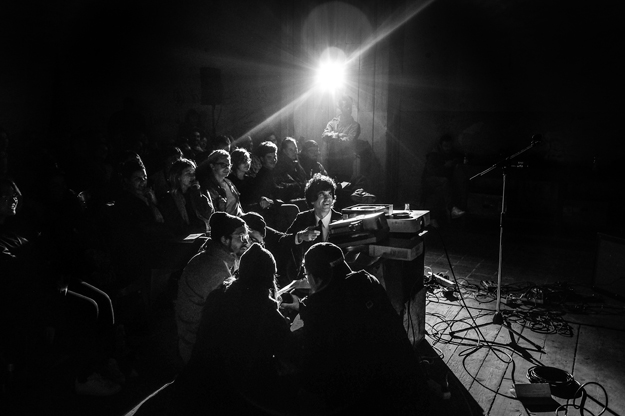
Photo: Atdhe Mulla / K2.0.
Before flying back home to the U.S., K2.0 sat down with an insomnia-suffering Svenonius to talk more about design and visual imagery, the Internet, Donald and Hillary, and of course, rock ’n’ roll.
In your lecture you started talking about rock ’n’ roll and graphic design…
I didn’t really get to my lecture but the lecture was about the group as design and how things are designed; how the entry point, the way we interface with things, defines that relationship and the way that thing will be used. [So, look at] rock ’n’ roll, which really came out of maybe black gospel music, a very… subversive form – community music; then it was designed to be a kind of component of individualist, capitalist, ideology to be exported around the globe, to serve as a kind of soft envoy of imperial power. All over the world rock ’n’ roll … serves as an apologist for U.S. colonialism, you know what I mean? Neoliberal invasion.
One of the sentences in the documentary script that the volunteers staged during your lecture raised the question: Is rock ’n’ roll a religion of pleasure or an ideology of consumerism? What is it for you?
Well rock ’n’ roll is a paradox and the workforce and the people behind it really define what it is. It’s always been a struggle. In the beginning rock ’n’ roll was kids in a corner signing harmony together, kind of an extension of gang life, an alternative society — it was. It has been commodified and consumerized one hundred times since. There are different struggles within the arena of rock ’n’ roll – the punk is another part of the struggle. And then the punk thing, how that’s recuperated by the reactionary forces, how can it be recuperated, how can it be kept interesting, that’s the struggle…
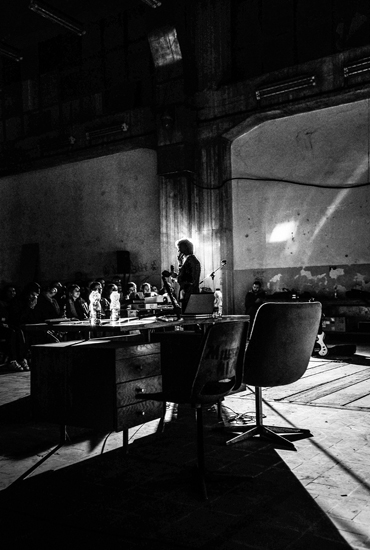
Photo: Atdhe Mulla / K2.0.
When computers were first being developed there was a very utopian idea that it would be a democratizing thing; when Apple revolutionized the computer they revolutionized it in a way where it would just be this very individualist, narcissistic, ‘selfistic’ way to project one’s will on the world. And that’s why you have this thing now which is just a bunch of people yelling about themselves. Through that we see politics developing in a way where everything is about the self. Everything is about identity. In America, at least, everything is about racial identity, sexual identity… everything has become identity politics, which is important, but you also have to remember geopolitics, you have to remember economy and the big issues that have a lot to do with the way we’re all controlled.
You’re talking about the way technology has influenced our global conversations. How has that technologic scenario, in which mainstream culture is so exposed and omnipresent, affected rock ’n’ roll and other underground styles?
If you look at the development of rock ’n’ roll, rock ’n’ roll existed for a long time before that, both black and white, elitist people making this primitive, rhythm music, and then it suddenly became exported very, very aggressively in the late ’50s. If you look at the timeline, that’s when jazz started becoming subversive, more overtly subversive – jazz had been this export of American culture. And the jazz musician started playing bop music. It became a little hard to control – esoteric. It stopped being so populist and became a little more avant garde, and rock ’n’ roll was packaged and exported as this American product…
People are going to influence one another globally regardless of imperialism or colonialism, and people are always listening to others. Colonialism, imperialism, have a lot to do with the way people hear music, but that’s why the British made rock ’n’ roll in the ’50s, because of American occupation of Britain. And the reason why Americans were using cha-cha-cha and rumba music, was because the Americans were occupying islands in the Caribbean. The ‘tiki’ craze comes from American occupation of Hawaii and the Pacific Islands… so that has a lot to do with the way people are absorbing music. But at the same time, people are always influenced because people are fascinated by difference and we’re always checking other people out.
What do you think about the current role of punk and rock ’n’ roll? Do you think it is now as politically engaged as it used to be in the ’90s? Or do you think that now that we’re in the times of Donald Trump punk should be stronger?
In a sense, I’d say George Bush and Donald Trump are punk presidents because the idea behind them is that they are not politicians; it’s almost an extension of punk to have these people up there ranting and saying vulgar things, you know? People forget that George Bush was very similar to Donald Trump; he wasn’t overly vulgar and he wasn’t such an extrovert – but he was an idiot. So punk ideology says: “Anyone can do it.” And the person who has not studied is better than a virtuoso.
The whole selling point of Hillary Clinton is that she is a virtuoso at statecraft. And the idea behind George Bush or Donald Trump is that they are real people who aren’t corrupted by the system. So you end up with a real crazy situation – Hillary Clinton is a mass murderer, and Donald Trump is a horrible monster.
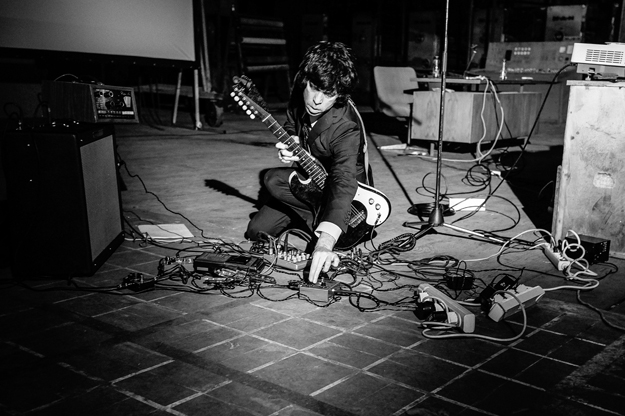
Photo: Atdhe Mulla / K2.0.
But I would say that punk has become very conservative because as it gets older, the histories that keep being made are being made with people who have gotten older. The perspective is being changed by the values of the culture, and the values of the culture now say that all those politics you cared about when you were young are really silly and embarrassing. When you ask them they just say: “Oh, it was all sex, we just wanted to get high…” When you listen to these histories of these people they are very banal, ordinary, not very interesting… If people were honest about what their motivations were, I think that it would be much more interesting.
Do you feel that age has affected the way you experience music?
Oh yeah… I think when you’re younger you are interested in what’s cool, by its association. The whole thing, when you are younger, it’s about who are your friends, and the association, the group; when you are old you feel more like an outsider, in a way, ’cause you are more alienated. So you are more interested in something that is totally alien.
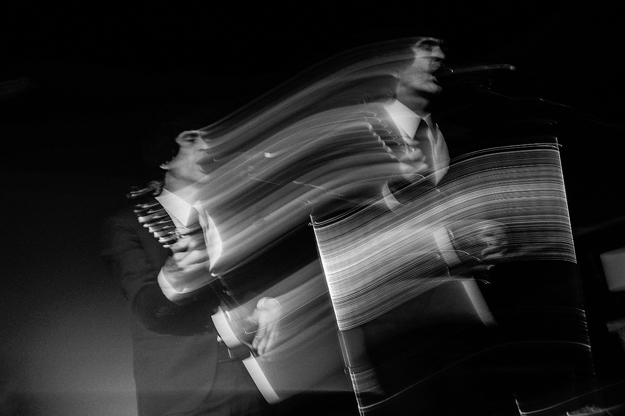
Photo: Atdhe Mulla / K2.0.
Your music and work are inspired by revolutionary politics. In the U.S. the Occupy Wall Street movement tried to revolt in a way, and Bernie Sanders’ campaign was presented as revolutionary. Did this inspire you in any way? Did you have any hopes?
Well, that’s silly. [Bernie Sanders] is obviously the best person to ever run for a president, but he is not a revolutionary, so at the end of the day if you don’t critique the actual system nothing is going to happen. If you look into Bernie Sanders’ foreign policy ideas, he was very conservative, he has the same stupid ideas as every other presidential candidate. He doesn’t question American institutions like NATO… but he has done a lot better than anybody else.
You have an internet TV series of interviews with musicians, Soft Focus. On it, you’ve had bands like Sonic Youth, Cat Power and Will Oldham – big names. Why did you decide to make such a program with people from the music scene?
Because there’s so little ideas that are getting out in the music… People in America are really afraid of pretension – being pretentious. Everything is supposed to be easy and cool, and the only emotions you get are, “Oh, I am angry – I hate Donald Trump, I hate Donald Trump, he sucks.” But there can be more of a discussion – which is a little bit lost – on the broader the more broad ideas.
Are you more interested in ethics and ideology than in the music itself?
I just like music and I’m just fascinated by the way things are developed. I read these histories in music and I’m offended by them because they seem very simplistic. I look at what created the music and I try to create a narrative which is different from the typical “Yeah, Elvis saved the world!” “Punk saved the world..” It’s very stupid.
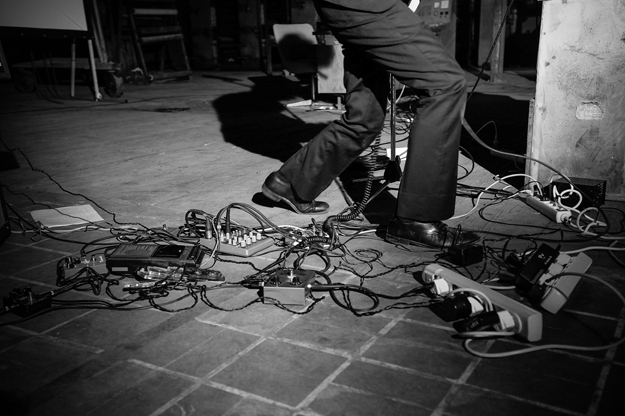
Photo: Atdhe Mulla / K2.0.
I want to see, “Why did these things come about?” and “What do they really mean?” because people who are involved in punk or rock ’n’ roll are often very self-congratulatory. They think: “Oh, well we got rid of the bad sex repression, we were so conservative, and now we’re free… .” It’s very stupid, you have to really think: What do these things really represent? In a lot of ways punk is really conservative… I’m not saying that in a bad way, I am conservative in some ways… And also, is punk even a thing? It’s a marketing tool…
The image of punk, it’s commercialized…
It was always commercialized. From the beginning. Think of the Sex Pistols, the group is designed; the Sex Pistols are just a design. Essentially, this was going to be the point of my lecture [at REDO]. Sex was a store, in Britain, run by Malcom McLaren and Vivienne Westwood. The Sex Pistols were models for the store, ’cause they thought instead of models we’d have a band. When they started they just did covers and they are a design element. Elvis is a design element – we have this white, country boy…
It’s all about the gesture. Rock ’n’ roll is a gesture. It’s more a gesture than a music. What do we call rock ’n’ roll? We call a craft rock ’n’ roll – anything can be rock ’n’ roll. It’s the same with punk: a noise artist could be punk; a folk artist could be punk… It’s about the gesture of the thing that they do; it’s very designed, and it’s been designed a lot of times by people who aren’t even musicians.
All the punk bands from England had managers, they were all very savvy, design-type-minded people, they had the whole concept about what the group would be and what space they would occupy in the constellation of groups. So The Clash, which was supposed to be a left group, they were this left-guerrilla group, drawing elements from leftist guerrilla, Sandinistas – they were the Che Guevara of rock… The Ramones are supposed to be this Bronx, Puerto Rican gang; that’s what they were supposed to look like, but mixed with ’60s garage.
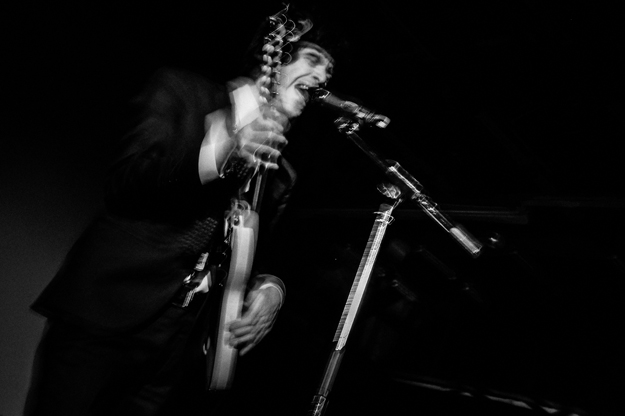
Photo: Atdhe Mulla / K2.0.
All these groups have a designed element that really overshadows what the group is in terms of the sound. The Grateful Dead… nobody knows what The Grateful Dead sound like but they know their skull… it’s these design elements that really overshadow what the group sounded like or the concerts that the group ever gave…

